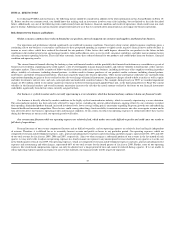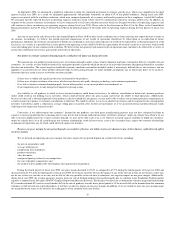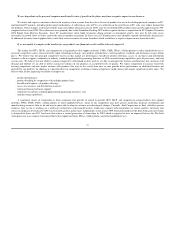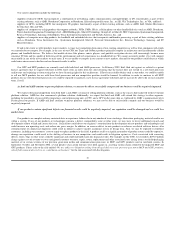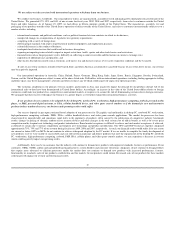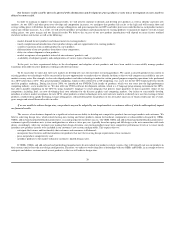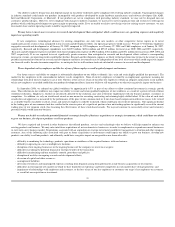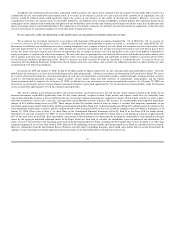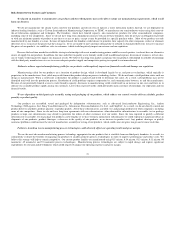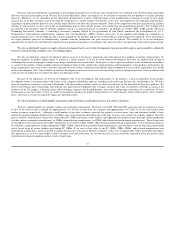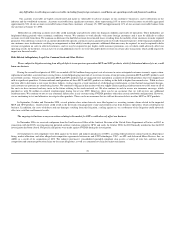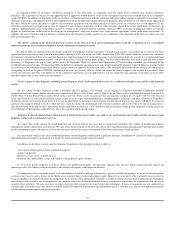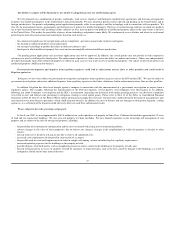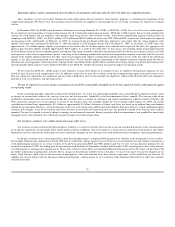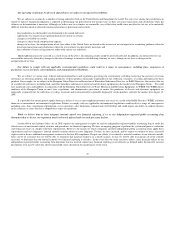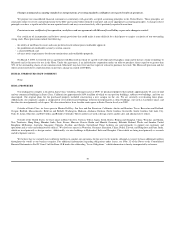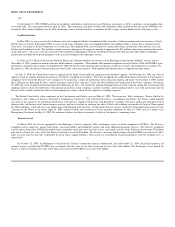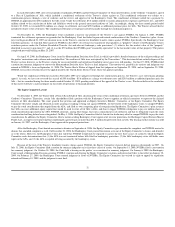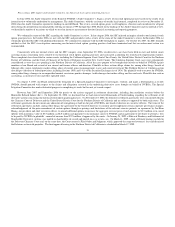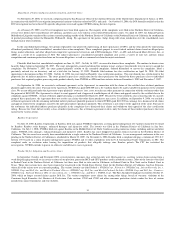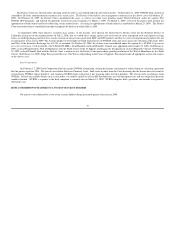NVIDIA 2008 Annual Report Download - page 28
Download and view the complete annual report
Please find page 28 of the 2008 NVIDIA annual report below. You can navigate through the pages in the report by either clicking on the pages listed below, or by using the keyword search tool below to find specific information within the annual report.
Any difficulties in collecting accounts receivable, including from foreign customers, could harm our operating results and financial condition.
Our accounts receivable are highly concentrated and make us vulnerable to adverse changes in our customers' businesses, and to downturns in the
industry and the worldwide economy. Accounts receivable from significant customers, those representing 10% or more of total accounts receivable aggregated
approximately 38% of our accounts receivable balance from three customers at January 25, 2009 and approximately 12% of our accounts receivable balance from
one customer at January 27, 2008.
Difficulties in collecting accounts receivable could materially and adversely affect our financial condition and results of operations. These difficulties are
heightened during periods when economic conditions worsen. We continue to work directly with more foreign customers and it may be difficult to collect
accounts receivable from them. We maintain an allowance for doubtful accounts for estimated losses resulting from the inability of our customers to make required
payments. This allowance consists of an amount identified for specific customers and an amount based on overall estimated exposure. If the financial condition of
our customers were to deteriorate, resulting in an impairment in their ability to make payments, additional allowances may be required, we may be required to defer
revenue recognition on sales to affected customers, and we may be required to pay higher credit insurance premiums, any of which could adversely affect our
operating results. In the future, we may have to record additional reserves or write
-
offs and/or defer revenue on certain sales transactions which could negatively
impact our financial results.
Risks Related to Regulatory, Legal, Our Common Stock and Other Matters
We are subject to litigation arising from alleged defects in our previous generation MCP and GPU products, which if determined adversely to us, could
harm our business.
During the second fiscal quarter of 2009, we recorded a $196.0 million charge against cost of revenue to cover anticipated customer warranty, repair, return,
replacement and other associated costs arising from a weak die/packaging material set in certain versions of our previous generation MCP and GPU products used
in notebook systems. The previous generation MCP and GPU products that are impacted were included in a number of notebook products that were shipped and
sold in significant quantities. Certain notebook configurations of these MCP and GPU products are failing in the field at higher than normal rates. While we have
not been able to determine a root cause for these failures, testing suggests a weak material set of die/package combination, system thermal management designs,
and customer use patterns are contributing factors. We continue to engage in discussions with our supply chain regarding reimbursement to us for some or all of
the costs we have incurred and may incur in the future relating to the weak material set. We also continue to seek to access our insurance coverage, which
provided us with $8 million in related reimbursement during fiscal year 2009. However, there can be no assurance that we will recover any additional
reimbursement. We continue to not see any abnormal failure rates in any systems using NVIDIA products other than certain notebook configurations. However,
we are continuing to test and otherwise investigate other products. There can be no assurance that we will not discover defects in other MCP or GPU products.
In September, October and November 2008, several putative class action lawsuits were filed against us, asserting various claims related to the impacted
MCP and GPU products. Such lawsuits could result in the diversion of management
’
s time and attention away from business operations, which could harm our
business. In addition, the costs of defense and any damages resulting from this litigation, a ruling against us, or a settlement of the litigation could adversely
affect our cash flow and financial results.
The ongoing civil actions or any new actions relating to the market for GPUs could adversely affect our business.
In November 2006, we received a subpoena from the San Francisco Office of the Antitrust Division of the United States Department of Justice, or DOJ, in
connection with the DOJ's investigation into potential antitrust violations related to GPUs and cards. In October 2008, the DOJ formally notified us that the DOJ
investigation had been closed. No specific allegations were made against NVIDIA during the investigation.
Several putative civil complaints were filed against us by direct and indirect purchasers of GPUs, asserting federal antitrust claims based on alleged price
fixing, market allocation, and other alleged anti
-
competitive agreements between us and ATI Technologies, ULC., or ATI, and Advanced Micro Devices, Inc., or
AMD, as a result of its acquisition of ATI. The indirect purchasers
’
consolidated amended complaint also asserts a variety of state law antitrust, unfair
competition and consumer protection claims on the same allegations, as well as a common law claim for unjust enrichment.
25


